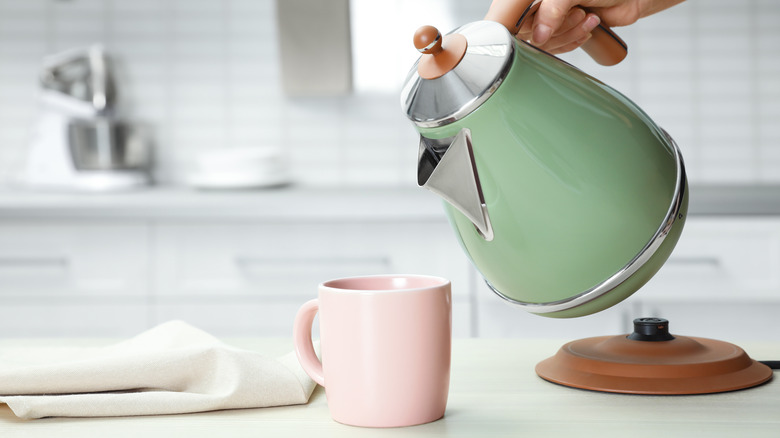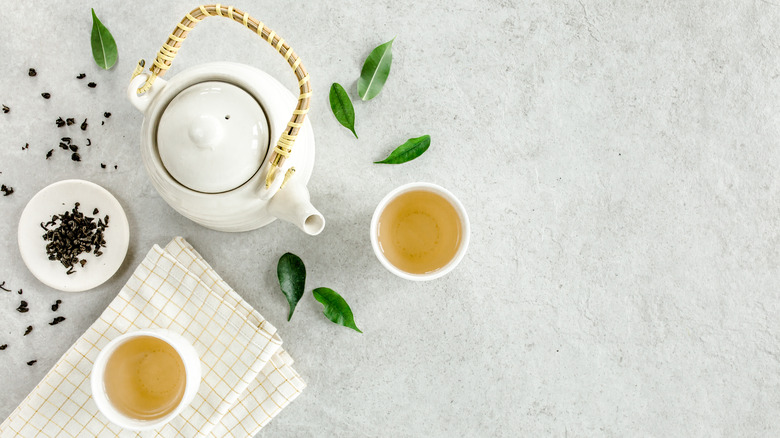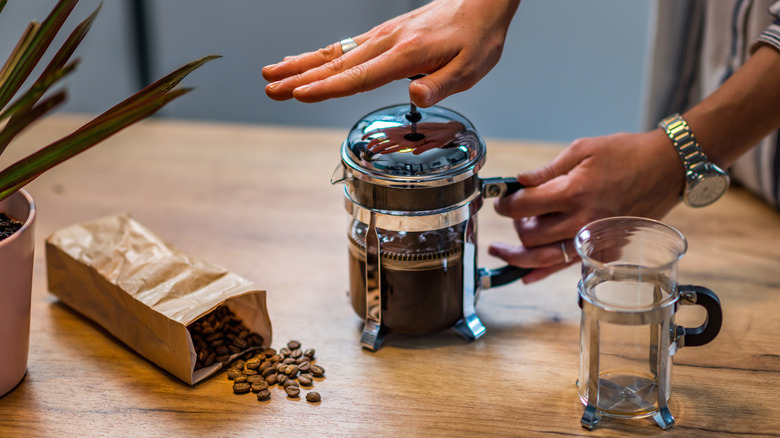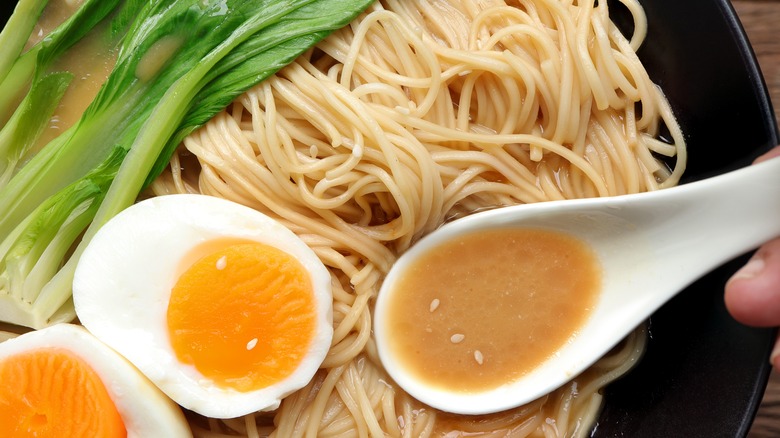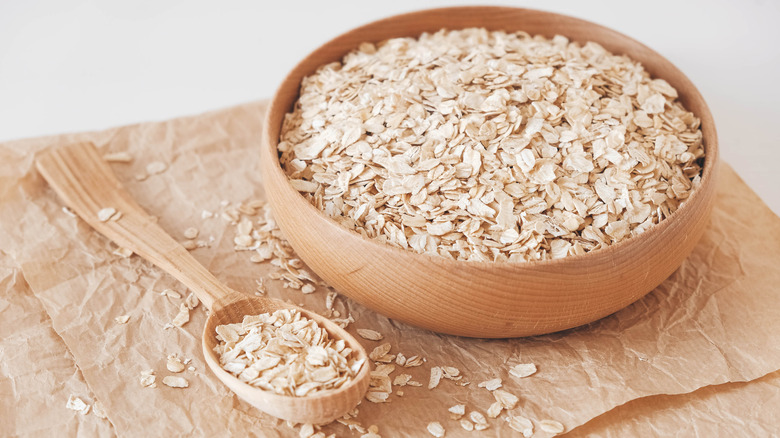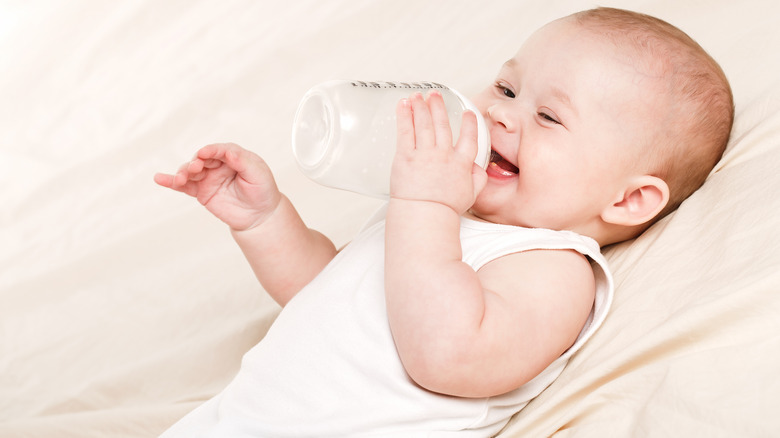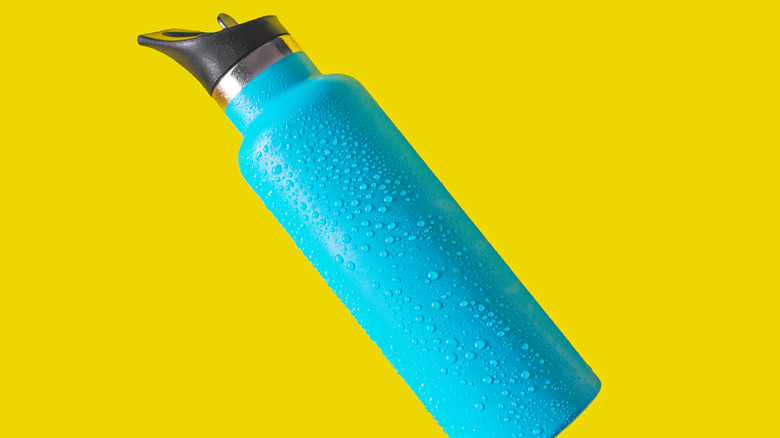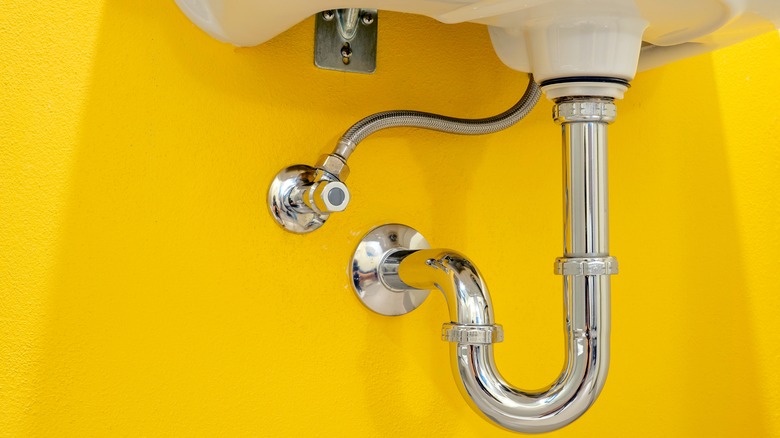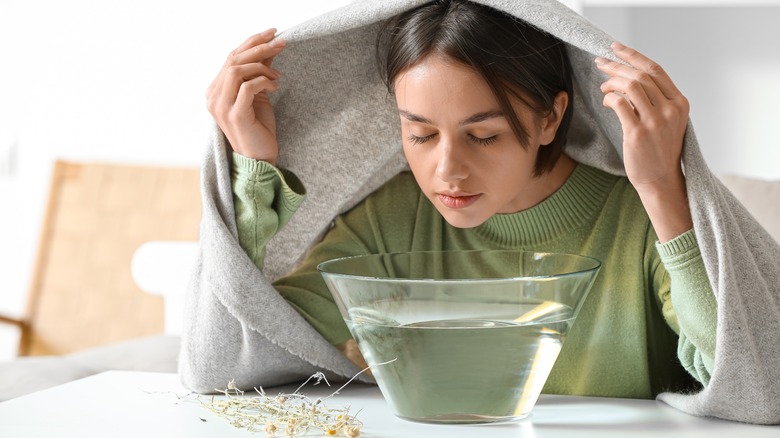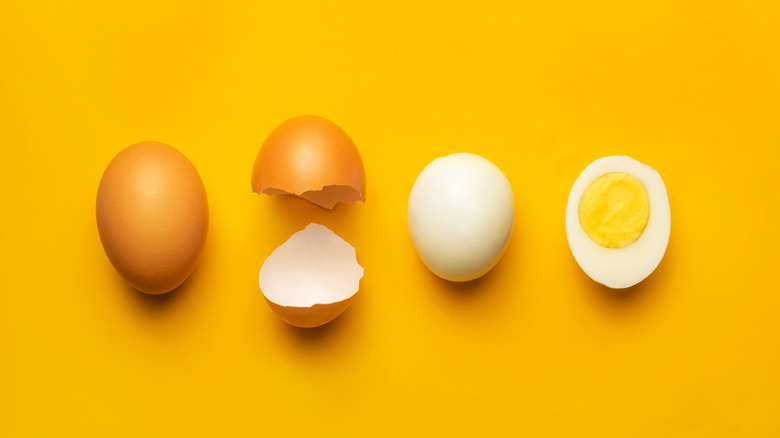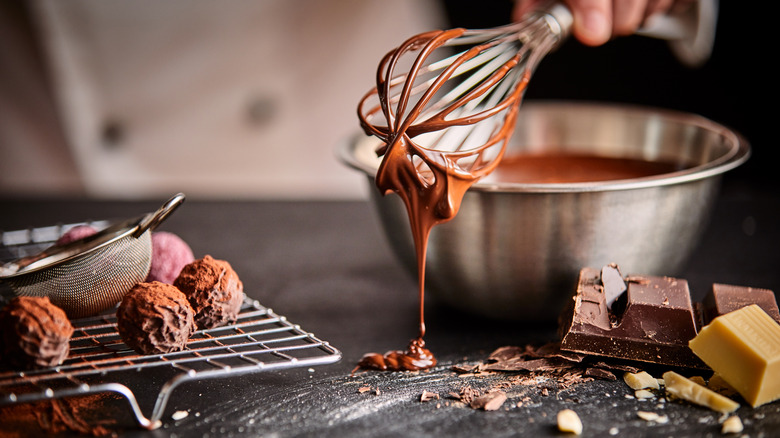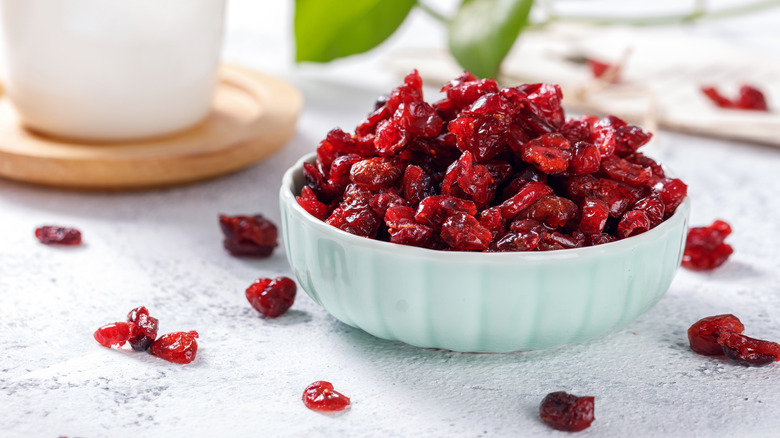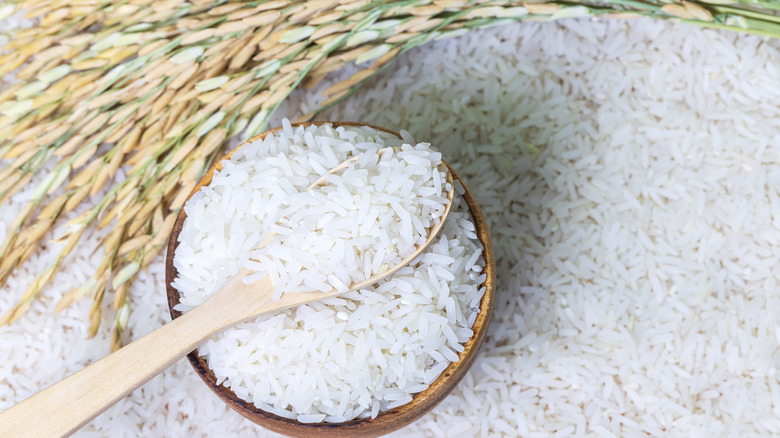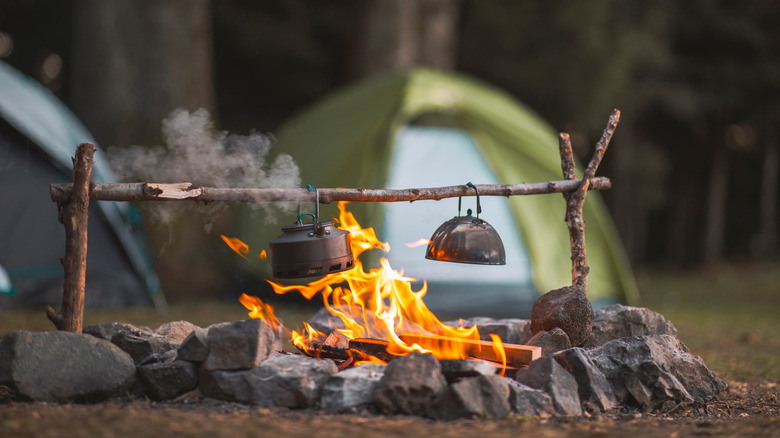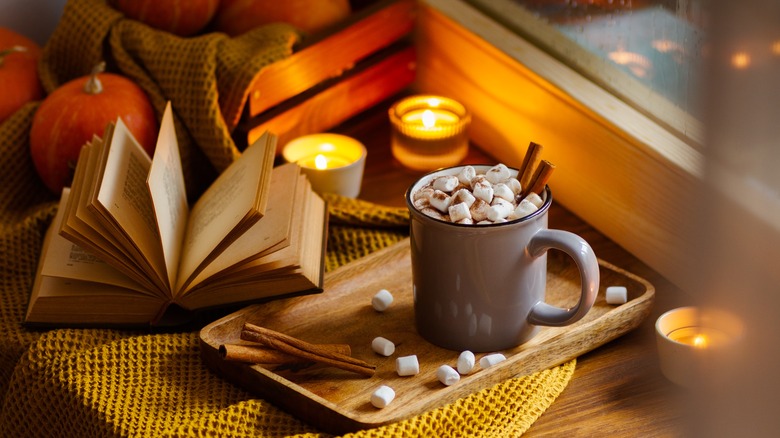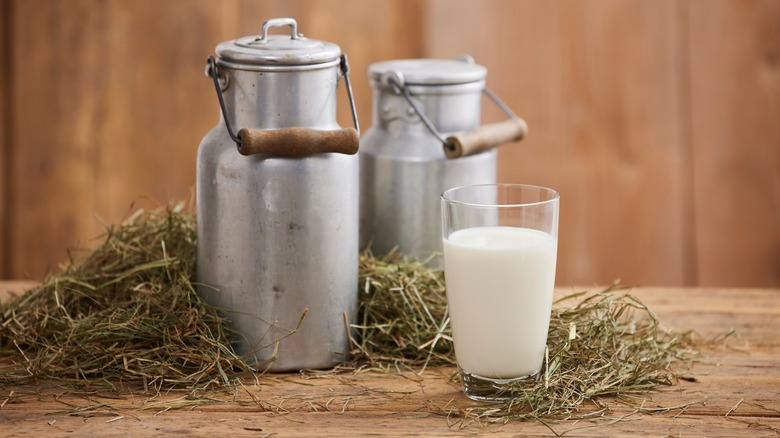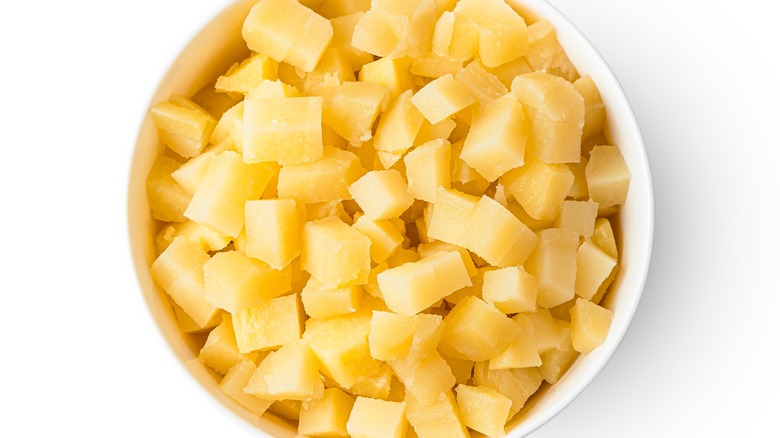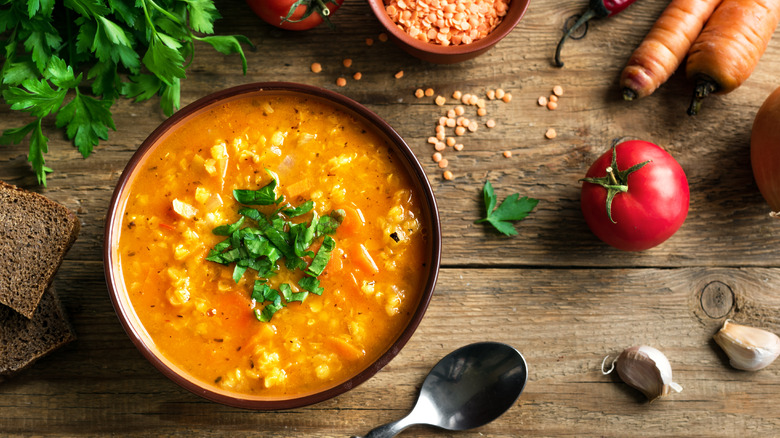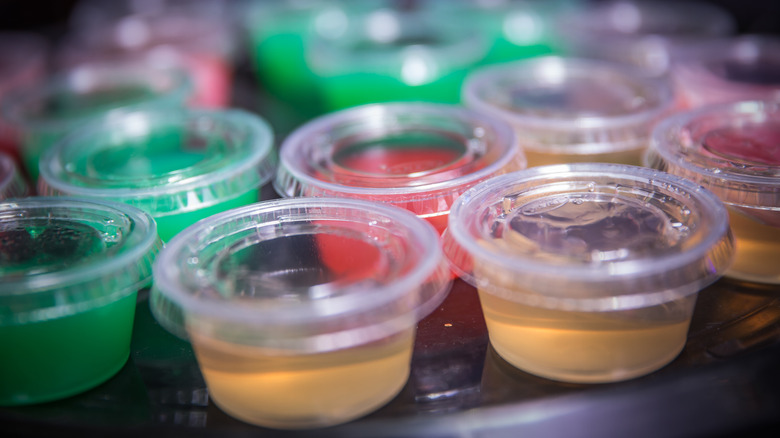The Absolute Best Uses For Your Kettle
We may receive a commission on purchases made from links.
The humble tea kettle is a convenient but oft-underestimated kitchen gadget. Boiling water has been used for food and drinks preparation since ancient times (via In The Kitchen). Around 3500-2000 BC, our ancestors developed the first primitive versions of the stovetop tea kettles we know today. However, the introduction of electricity, along with the massive technological advancements that have taken place in the last century, have helped the tea kettle evolve beyond its origins. The tea kettles of today are manufactured in every color of the rainbow, can heat a liquid to specific temperatures, and some are even controlled by apps right from your phone. Cheaper (but perfectly functional) models can be purchased for under $25 on Amazon, while advanced or luxury products can make quite a dent in your wallet.
The spectrum for types of tea kettles is mind-bogglingly broad, but the functions boil down to essentially the same thing: Kettles are made to heat water and other liquids. As the name suggests, most people use their tea kettles to brew tea or perhaps the occasional coffee — but just as there are myriad uses for your coffee maker, there's a slew of creative applications for your kettle. These handy appliances aren't just for tea lovers. If you're savvy enough to think outside the box (or, in this case, the kettle), then this is a practical gift for college students, camping aficionados, hotel frequenters, and of course, anyone who just likes to curl up with a nice cup of tea.
Making tea
As you might expect, tea making is just about the most basic use of a kettle. Tea can be brewed with either a stovetop model (keep in mind that you'll need access to a stove or alternative outside heat source) or an electric kettle (which will come with its own heat source). Each version has particular advantages. As Alternative Brewing explains, stovetop kettles are your best bet if you need to heat water above its boiling point and keep it there for a rolling boil, while electric teapots warm up water faster.
Another advantage of electric kettles is the ability to heat water to different temperatures, although not every model includes this helpful feature. There are countless tea varieties these days and myriad ways to prepare them. According to Artful Tea, using the proper temperature for each type will give you the best brew. Some teas, like herbal, black, and rooibos, should be prepared using water that has reached a boiling point of 212 F, while other teas require significantly lower temperatures (150 F for yerba mate, 175 F for matcha). If you're a tea connoisseur and you plan on mostly using your kettle to brew tea and coffee, the temperature control afforded by a good electric kettle can't be beaten.
Brewing French press coffee
For many of us, there's no better way to start the day than with a piping hot mug of java. The world is your oyster when it comes to coffee; interestingly enough, some of the population's most extreme coffee savants swear by an incredibly simple brewing method — the French press. While the brewing science behind French press coffee may not be quite as easy as popping a pod into a Keurig, it makes for a more nuanced brew and is a great way to utilize your tea kettle.
All you need for a French press coffee is coarsely ground coffee (grinding your beans is highly recommended), the French press apparatus itself, and hot water (according to The Roasterie, water should be heated to approximately 200 F for the perfect French press). For a single serving, pour two tablespoons of ground coffee into the French press, then add one cup of the hot water and stir together. Allow the mixture to steep for about four minutes, then press down on the French press plunger, trapping the grounds in the bottom of the machine and allowing the fresh coffee to float through the strainer to the top.
Boiling instant noodles
Once exalted by college students and other folks struggling to stretch their food budgets, instant noodles are no longer seen as the savior of the broke(n) but rather as a wallet-conscious starting point for a nutritious and Instagram-friendly meal in a bowl. Instant noodles are a quick, cheap, and easy dinner that requires minimal preparation and cleanup.
Just add hot water from your tea kettle to your Cup O' Noodles container, or toss your ramen noodles and hot water into a bowl with the seasoning packet. Let it sit for three minutes, and you've got lunch (or dinner or breakfast if you want to shake things up). Eat your hot noodles as they are, or give your ramen an upgrade with add-ins like eggs (they'll cook right in the hot broth if you add them right away), pork belly, bok choy, cilantro, and spices. Bon appétit!
Making oatmeal
Oatmeal is cheap, healthy, and, most importantly, delicious. According to WebMD, studies show that eating oatmeal can help lower cholesterol, improve heart health, and lower blood sugar, among other benefits. It's also ridiculously simple to make, requiring only oats, hot water, or milk. Dairy and non-dairy milk, like almond, oat, or hemp, can be used. If you're out of milk but don't want to make oatmeal with plain water, you can even cook a surprisingly delicious bowl using tea! Just be sure to clean out your kettle thoroughly afterward with hot, soapy water if you're boiling anything besides water in the pot.
Once cooked, there's a lot you can do to transform your oats from a bowl of mush into a tasty, well-rounded meal. Try adding sliced bananas for a fiber boost, spiced almonds for healthy fat and flavor, or cooked bacon or sausage for protein. On the go? A honey packet or pinch of brown sugar is a great way to spice things up.
Warming bottles
Some parents like to warm their babies' bottles of formula or breast milk. If your electric tea kettle has temperature control, you can boil water in the pot and allow the bottle to sit in the warm water for up to five minutes. Bear in mind that the Iowa Department of Public Health warns that bottles should not be placed in water exceeding 120 F, so make sure you set up your kettle to heat the water to that temperature or slightly below.
Alternatively, some people swear by hot water bottles for easing muscle pain, menstrual cramps, and other ailments. As Medical News Today posits, applying heat to an affected area can help muscles relax by improving blood circulation, which can alleviate everyday aches and pains triggered by exercise, certain health conditions, and from simply being a human. Hot water bottles and other heating devices should never be used on irritated skin, on an open wound, or on a part of the body that has gone numb.
Sterilizing water and bottles
If you have a water bottle you love, it's important to treat it right! Water bottles can build up debris containing harmful bacteria around the lid and mouthpiece when they're not cleaned often enough. Fortunately, cleaning your bottle is a cinch with a stovetop or electric tea kettle. Water bottle manufacturer Flaske recommends filling your water bottle with hot water and a sterilizing agent like vinegar, baking soda, or bleach to give it a good deep clean.
Those living in areas that frequently experience water supply contamination can benefit from boiling water too. In emergencies where the water supply is compromised, the CDC recommends heating water to a rolling boil for about one minute and allowing the liquid to cool to room temperature before consumption. This technique can be an absolute lifesaver during emergency water shutoffs, natural disasters, and other dangerous situations where access to safe drinking water is impossible.
Unclogging drains
Nothing mucks up your kitchen or bathroom routine like a clogged drain. Fortunately, there are a couple of easy DIY fixes you can try before dialing your plumber, and one of them allows you to use your tea kettle in a way you may not have thought of before. While it won't fix more severe clogs, Liquid-Plumr suggests attempting to clear your drain by pouring a full kettle of boiling water down the affected duct, then tipping a mixture consisting of one cup room temperature water, one cup baking soda, and one cup vinegar down after the boiling water.
What makes it work? Mixing together acidic vinegar and basic baking soda creates a chemical reaction that produces carbon dioxide and a whole lot of bubbles. The bubbling effect cuts through minor clogs and causes them to disintegrate into smaller pieces. It's worth rooting around your pantry for some baking soda and vinegar if you find yourself with a plumbing jam. This is a situation in which stovetop kettles, which are best for creating and maintaining a rolling boil, take the cake over electric units!
Clearing up blocked sinuses
Blocked drains might be a pain, but stuffy, clogged sinuses can absolutely ruin your day. Whether you're suffering from allergies, a winter cold, or a chronic sinus condition, sometimes sinus medication just doesn't get the job done. Enter your tea kettle. Per Healthline, breathing in hot steam is reported to slacken and undo mucus buildup in the throat, lungs, and nasal cavities — a.k.a. the areas commonly affected by clogged sinuses.
For a home steam treatment, heat water to boiling in your teapot, then pour it into a wide-mouthed bowl. Drape a soft towel over the back of your head and lean over the bowl of piping hot water (your face should be about a foot from the water's surface), taking deep breaths to inhale the soothing steam for two to five minutes. Consider adding a few drops of calming lavender or relaxing chamomile essential oil to the hot water in order to feel like you've been transported to your favorite spa. This process can be repeated three or four times daily until your sinuses are free of blockage.
Making hot toddies
Have you ever had a hot toddy on an icy, bone-chilling cold day? If not, you're missing out! Hot toddies warm a person up from the inside out, and because of the honey, lemon, and whiskey or rum included in a classic hot toddy recipe, the warm drink can help soothe a cough or sore throat too. Just think of it as a tea with an extra punch of fun. The Mayo Clinic reports on studies that show that honey may be an effective cough suppressant, and lemon has long been regarded as a remedy for a frog in the throat.
To make a hot toddy, you'll combine boiling water from your teapot with honey, lemon juice, and whiskey, then garnish the drink with sweet and woody cinnamon and star anise. One or two of these drinks will have you feeling warm to your toes — it's the perfect way to round out an afternoon at the apple orchard, a day on the slopes, or a late autumn camping trip. Make a non-alcoholic version by leaving out the booze, and you've got a great fall beverage the whole family will enjoy.
Cooking hard boiled eggs
There's nothing hard about hard-boiled eggs! They're an excellent source of protein — as Healthline explains, an individual hard-boiled egg (which is the recommended serving size) contains about 77 calories and six grams of protein with only five grams of fat. They're also easy to prepare once you nail the method down. You don't even need a stove to cook them up, in fact; you can make them right inside your electric kettle! Keep in mind that depending on the size of your kettle, you may not be able to fit as many eggs inside as you might squeeze into a large saucepan, stewpot, or Instant Pot.
Taking care not to crack the shells, place your eggs right into the interior of your electric kettle and fill the pot with cool or room temperature water until the water level is about an inch above where the eggs are resting. Heat the entire contraption until the water is boiling, turning the tea kettle off once it's boiling. Allow the eggs to soak in hot water for 15 minutes, then use tongs or a spoon to move the eggs into an ice bath carefully. Once the eggs have cooled, you can eat them as a handy on-the-go snack, chop them up and add them to a salad, or make a batch of upgraded deviled eggs for a party.
Melting chocolate
Count yourself lucky if you've never made the mistake of trying to melt chocolate directly on the stovetop. Chocolate melted on the stovetop tends to clump and burn, which is not ideal for the smooth, melted chocolate used for fondue, coating cake pops, creating a hard layer of chocolate frosting, and more. Instead, melt chocolate in a double boiler, which is easily achieved with your stovetop or electric kettle.
A double boiler consists of a small bowl filled with the food item that needs to be melted and placed over a large pot filled with hot water. Stovetops are handy for double boilers because they provide a consistent heat source, but if you find yourself in a pinch, reach for your kettle. Heat water in your kettle until it's simmering, then pour it into a pot or saucepan. Place your chopped chocolate or chocolate chips into a bowl that can fit inside the water bowl without falling in (if the chocolate bowl is too small, it will fall through, and you'll get water in the chocolate — yuck!). Stir the chocolate consistently until melted, adding more hot water to the bottom bowl if needed, then use the melted chocolate as your recipe directs.
Rehydrating dried fruits
Dried fruits are dangerous for anyone with a sweet tooth. They're syrupy and delectable, and it's easy to consume far more than the recommended serving size in one sitting. However, that's not to say they're without their benefits. As Harvard Health Publishing's Editor in Chief explains, dried fruits actually contain more fiber and antioxidants per ounce than fresh counterparts, so as long as you're consuming raisins, dried cranberries, and dehydrated mangoes in moderation, they pack a decent nutritional punch.
If left out too long, your craisins and dehydrated apricots will transform from yummy bites of gummy goodness into rock-hard morsels. When you accidentally leave it out too long, and your dried fruit is too hard, your tea kettle can be your saving grace. All you need to do is place your dried fruits into a bowl and throw in enough boiling water to cover it. Let it soak for ten minutes, then use a spoon or fork to fish out a piece or two and gauge the softness — if still hard, allow it to soak for an additional three to five minutes. Dry off the revitalized bites with a paper towel, then return them to the fruits to the original container or Tupperware when dried.
Making perfect rice
Rice helps round out a meal with starch, carbohydrates, and almost zero sugar or fat (per Medical News Today). It's a staple in many world cuisines and makes a perfect base for meals like this slow cooker butter chicken recipe, power-packed grain bowls, and family-favorite sides like 20-minute fried rice. As if rice's accessibility, versatility, and low price point per serving didn't make it appealing enough, it can also be made with a tea kettle exactly the same way as you would on a stovetop.
Cooking rice in a kettle makes it a game-changing hack for campers, college kids in dorm rooms, and anyone else who doesn't have access to a stove. In fact, world-renowned chef and TV personality Alton Brown actually recommends using a tea kettle to prepare marvelous, fluffy rice when in a rush. His simple method requires only water, rice, butter, and salt. Try it out the next time your stove is on the fritz or on your next backpacking trip.
Cooking while camping
Speaking of backpacking, many of the foods on this list are great choices for camping food because they're easy to carry in a pack or cooler. Most campsites (and certainly not rugged trails in the middle of nowhere) don't have hot water readily available, and having a stovetop tea kettle will increase your cuisine options tenfold. A stovetop tea kettle doesn't actually require a stovetop: It can boil water when placed over any kind of heat source, including the open flame of a campfire.
A teapot does take up a considerable amount of space in a backpack, but it's well worth it if you like to get a little fancy with your camping recipes. If you can build a fire or you've brought along a camping grill, boiling water for hot dogs, brewing coffee, blanching vegetables, or making a nice bowl of hot oatmeal is a breeze.
Brewing hot chocolate
Hot cocoa is among the very easiest of beverages to fix, but it's also a ritual beloved by many. Pre-made packets of hot chocolate are readily available in supermarkets, convenience stores, and gas stations. You won't find a huge selection in every store, but just about every form of chocolate under the sun is available in cocoa form these days: dark hot chocolate, white cocoa, milk chocolate, and more. Hot chocolate can also be made with milk (dairy or non-dairy), which leads to a richer, frothier beverage.
The most basic hot cocoas from packets or packed powder require nothing more than mixing a hot chocolate packet (about two tablespoons of powder) with ¾ cup of hot water or milk from your kettle but don't stop there. There are lots of fun variations that will give your cocoa a major upgrade, like sweet strawberry hot chocolate recipes or citrusy orange hot chocolate, all of which can be made using a tea kettle.
Scalding milk
Before pasteurized milk was a thing (per the CDC, selling raw or unpasteurized milk has been unlawful in the United States since 1987 due to concerns over disease outbreaks), many recipes called for scalding milk to prevent risk. Nowadays, scalding milk is much less common, but if you're an avid cook or baker, you'll still come across the odd recipe that calls for scalded milk. Using scalded milk in recipes means cooking milk to a near-boiling temperature. While we no longer need to worry about exposure to disease from raw milk, scalding helps to deactivate whey proteins (which prevent rising during baking) and can infuse the milk with deeper flavors.
To scald milk, it must be heated to around 170-180 F, so an electric kettle with temperature control can be very helpful in heating the milk to the temperature you need. In order to achieve this, add milk directly into the electric kettle and start it off at low heat to avoid burning. Once the milk is heating, adjust the temperature of the tea kettle to 170 F, keeping a close eye on the pot. Once you can see little bubbles around the edges of the teapot, immediately remove the kettle from its heat source. Using this admittedly painstaking method will prevent the milk from boiling over or becoming burned.
Boiling potatoes
Who doesn't love potatoes? One of the most versatile pieces of fresh produce, potatoes can be prepared in seemingly infinite ways, many of which require boiling. The vast majority of recipes for boiling potatoes instruct the cook to start with cubed potatoes in a pot of cold water. Still, with a simple and ingenious tea kettle hack, it's possible to half the cooking time for potatoes. Rather than setting the potato chunks and cold water in a pot on the stove and waiting for the concoction to boil, heat the water in the tea kettle (an electric kettle will be quickest) and place the potatoes in a saucepan on your stovetop. Once the kettle water is boiling, pour it over the cubed potatoes and fire up the burner, maintaining a heat that keeps the solution at a simmer for about five minutes or until the potatoes are fork-tender.
Technically, you can cook cubed potatoes right in the kettle. However, as Worthy Recipe explains, it's not recommended due to concerns about correct cooking temperature and safety issues with the appliance itself. However, because electric kettles can bring water to a boil so quickly, using the kettle-and-stovetop method explained above will take only a few seconds longer than boiling the potatoes in the teapot itself.
Blanching vegetables
Green-thumbed home gardeners occasionally find themselves in the predicament of having more produce than they can use before it goes bad. Luckily, there are a few tricks to preserving vegetables in a prime state that don't involve tossing piles of perfectly good produce in the trash, and one of those stratagems is blanching and freezing. Blanching is an often-overlooked technique that preserves flavor, color, and nutritional value in certain vegetables. Essentially, you're submerging produce in boiling water for a short time before plunging it into an ice bath.
It's as simple as it sounds, and your tea kettle can be a big help when it comes to the hot water bath. Note that you'll need about one gallon of water per pound of veggies, so if you're the proud owner of multiple kettles (either stovetop or electric will work), it's time to put them to work. Place the desired produce in a blanching basket and submerge it in hot water before securing the lid of the blancher. Let the veggies sit in the hot water for the appropriate amount of time — different vegetables require different blanching times, per Clemson University — then plunge them into a large bowl or pot of hot water to immediately stop the cooking process. Once cooled, drain and dry the vegetables before freezing them.
Making a simple soup
On a cold day, a warm cup or bowl of scratch-made soup is an exceptional comfort. Hot broth and cooked vegetables nourish both the body and the soul, but sometimes you just don't feel like digging your soup pot out of your cupboard or running to the convenience store for a can of premade soup. The next time you're hit with a soup craving, consider making a simple stew right in your electric kettle. It's a great way to use up the last of those carrots you bought last week or to stop throwing away wilted produce leftover from this week's meal prep.
All you need to do is add your choice of fresh vegetables (broccoli, onions, potatoes, mushrooms, or whatever you have on hand) and herbs (garlic is an excellent flavoring choice, and herbs like fresh basil, oregano, or thyme will give your soup a tasty pop) right into the kettle. For liquid, you can use plain water or chicken, beef, or vegetable broth for a deeper taste — add enough water or broth so that the vegetables are submerged at least one inch deep. Turn the kettle up to its highest setting and let the soup sit for at least five minutes after the kettle shuts off to finish cooking. You can also heat up canned soup this way in a pinch. Whatever soup you make, just be sure to clean your kettle thoroughly with soap and hot water afterward.
Mixing Jell-O
While its nutritional value is virtually nonexistent, Jell-O is a fun, yummy, and easy-to-make treat for kids and adults alike, and everyone needs a little something sweet in their life now and again! With the wide range of Jell-O flavors available and the broad array of molds and cookie cutters on the market, you can make your gelatin treat to look and taste like just about anything. Think jiggly Jello-O ghosts for Halloween, a red, white, and blue Jell-O cake for the 4th of July, or this champagne Jell-O shot recipe to celebrate an anniversary. The options are limitless, and your tea kettle can be a big help.
To make a basic Jell-O, empty a Jell-O packet into a medium-sized mixing bowl, add one cup of boiling water from your kettle and stir until the powder is dissolved, then stir in one cup of cold water. Pour the mixture into a bowl or mold — this is where you can have some fun! There are lots of pans and molds that will form the gelatin into shapes like Christmas trees, kangaroos, shooting stars, unicorns, and much more once it's hardened. After pouring the Jell-O into the pan or mold, transfer it to the fridge and allow it to cool for about four hours, or until firm.
